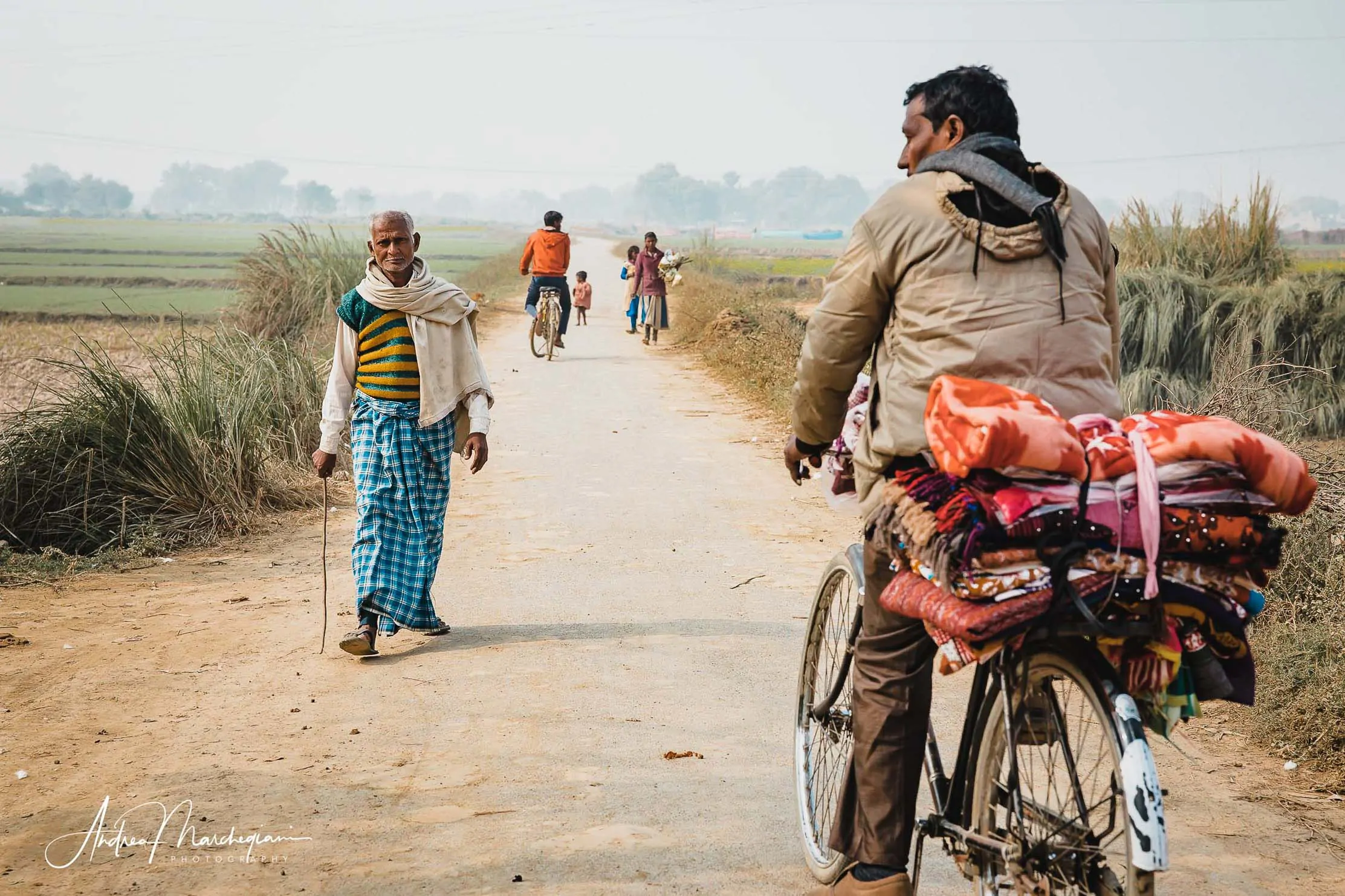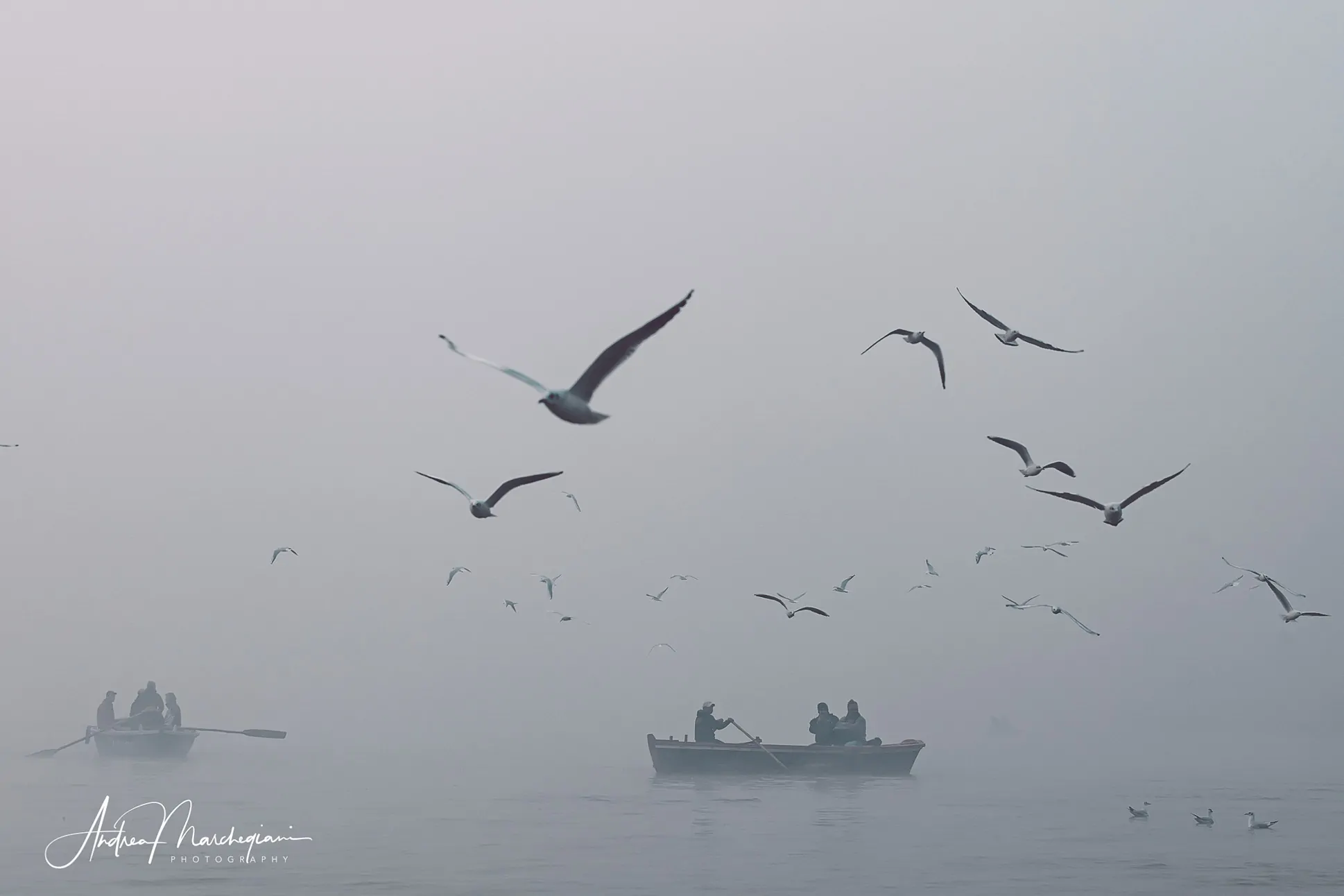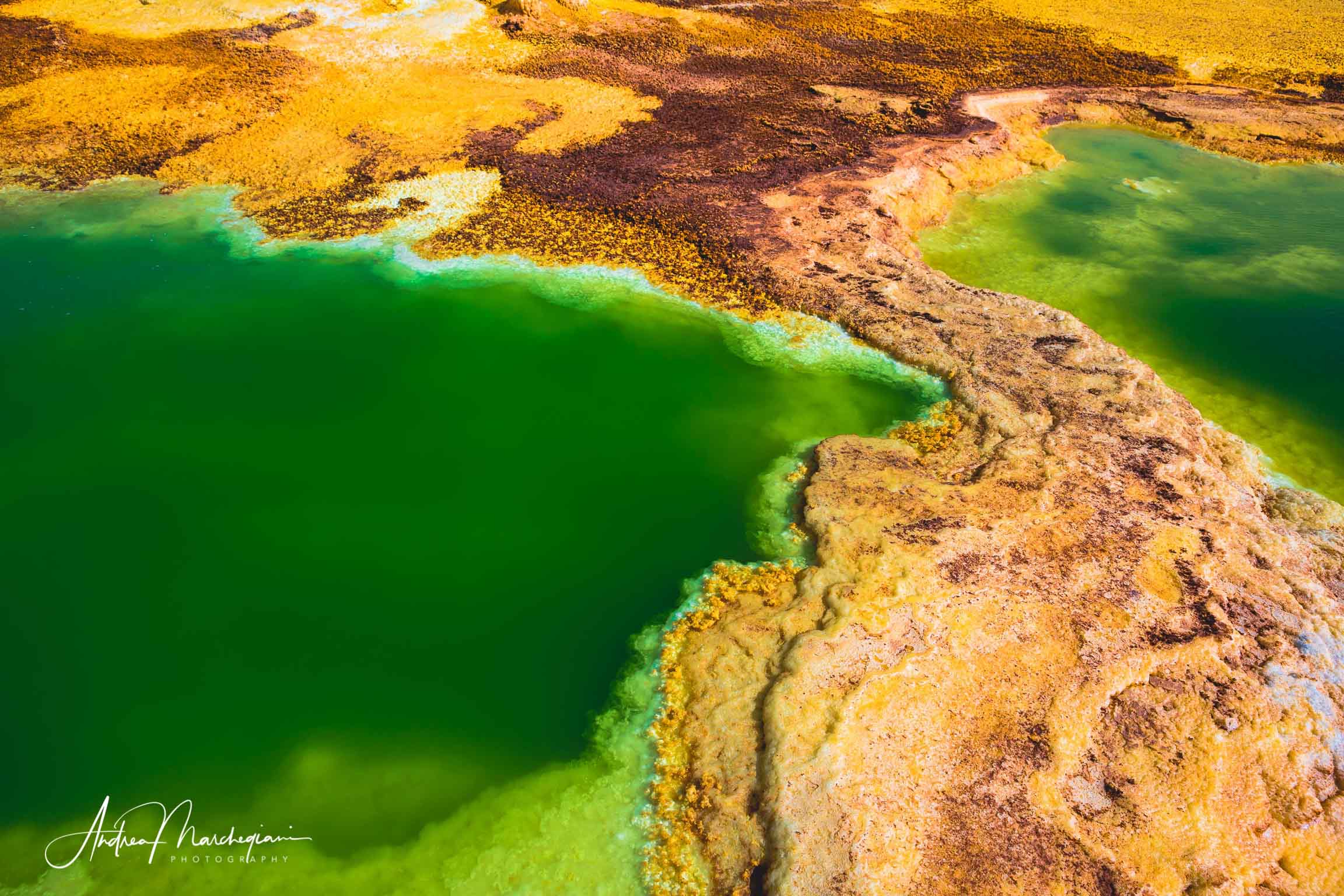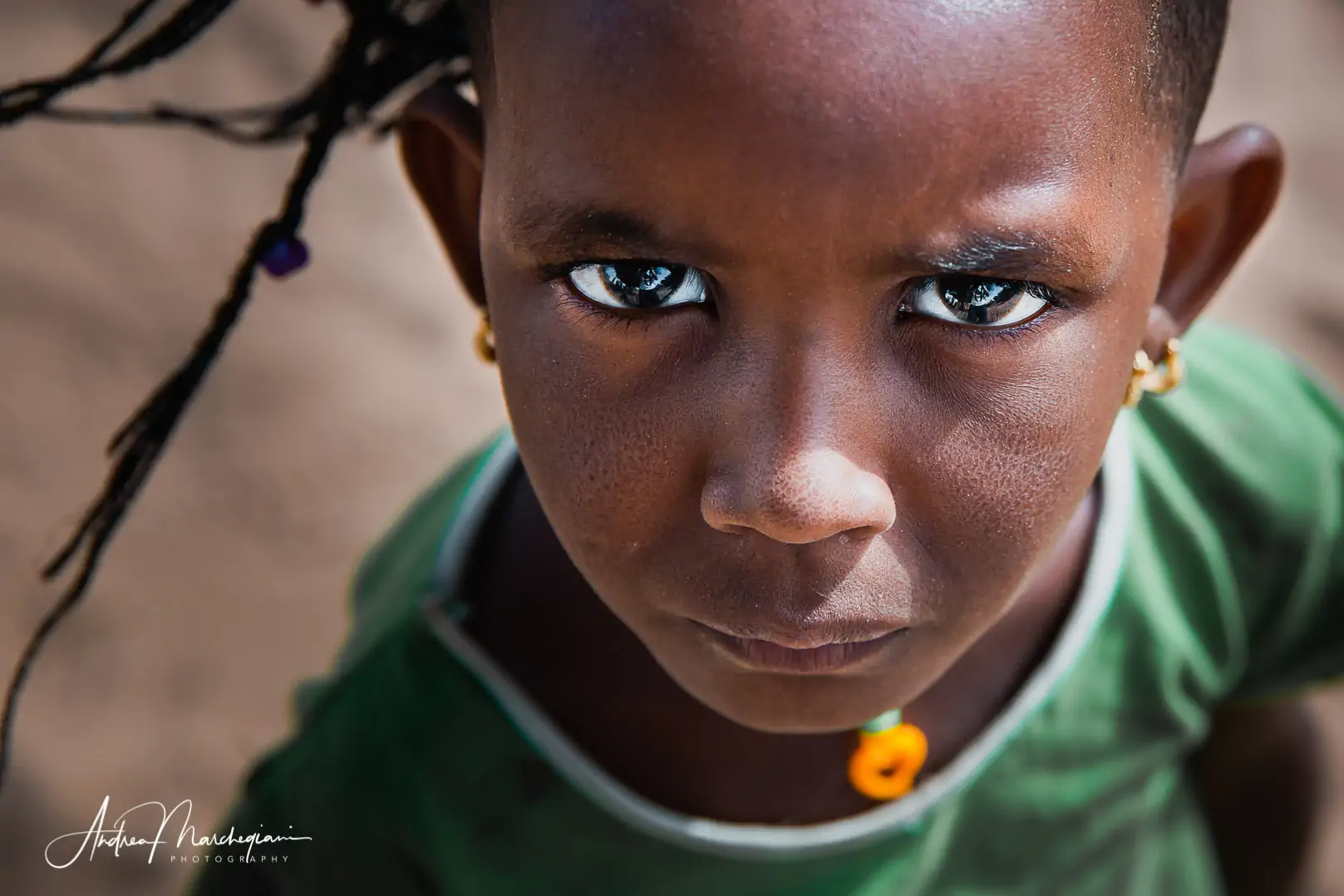
- Home
- Photo Galleries
- Portrait Photography
- Landscape Photography
- Street Photography
- China
- Ethiopia
- India
- Holy Ganges
- Varanasi
- Varanasi Ganga Aarti
- Varanasi, Manikarnika Ghat
- Varanasi Streets & Alleys
- Varanasi Demolition
- Varanasi Fruit Market
- Sarnath
- Brick Kilns
- Tamil Nadu, Chennai & Mamallapuram
- Tamil Nadu, Fort Tirumayam & Madurai
- Tamil Nadu, Tiruvannamalai & Thanjavur
- Kerala, Munnar
- Kerala, Peryiar
- Kerala, Backwaters
- Kerala, Kochi
- Kazakhstan
- Myanmar
- Senegal
- Uzbekistan
- Travel Blog
- China
- Ethiopia
- India
- Tamil Nadu & Kerala
- Varanasi
- Whato to do in Varanasi
- Varanasi Life along the Ghats
- Varanasi Death along the Ghats
- Varanasi Ganga Aarti Ceremony
- Varanasi demolished to honor Shiva
- Varanasi Fruit Market
- “Varanasi, A Journey into the Infinite”
- Sarnath
- All about River Ganges
- Holy Shit. All about Indian Cow Dung
- Clean India Project
- Brick factories
- Tilaka, pundra, bindi: what is the mark on Indian foreheads?
- Kazakhstan
- Mongolia
- Ulaanbaatar, the coldest capital in the world
- What to do in Ulaanbaatar
- Chinggis Khan Museum, 6 floors of Mongolian history
- Gorkhi-Terelj National Park and Bodgkhan Natural Reserve
- Altai Mountains, Things to do in Olgii and Sagsai
- Living with the Eagle Hunters
- Sagsai Eagle Festival
- Navrus Festival
- Xöömej, Mongolian throat singing
- Mongolian Food
- Myanmar
- Senegal
- Uzbekistan
- Latest Posts
- Photography Blog
- About
- Prints
What is a portrait photograph? What are the best lenses and what composition to choose? How to compose a good portrait while traveling? How to approach subjects for our photos? Practical tips and on-field examples for capturing professional portrait photographs during a trip.
© Article and Photos by Andrea Marchegiani. Unauthorized reproduction prohibited. Permission granted for publication in TUTTI FOTOGRAFI January 2021.
Share with your friends:
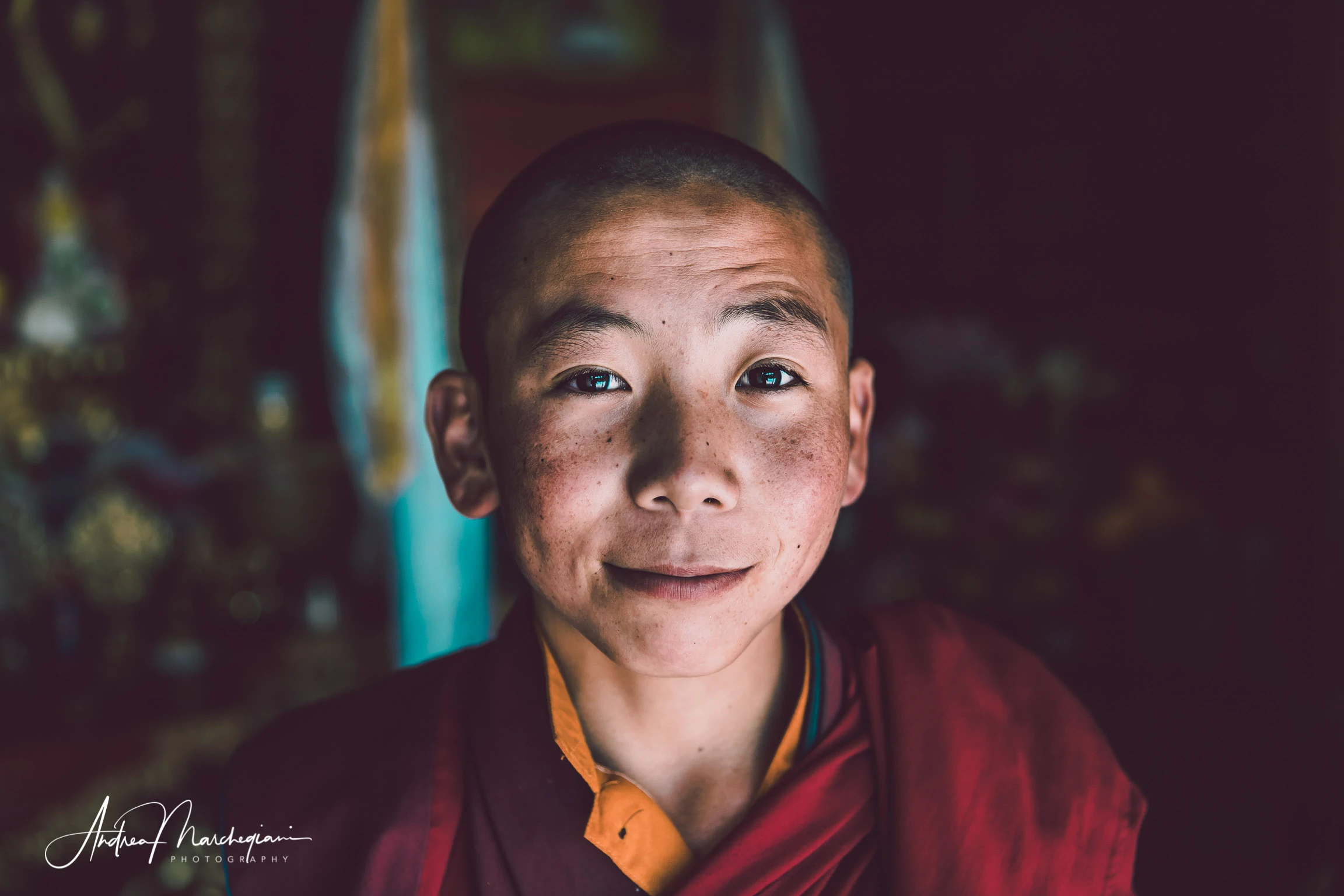
Travel photography is not a genre in itself. When we travel, we engage with all existing genres, and it is not easy to achieve good results with limited resources. Often, we don’t have our entire range of lenses with us, we can’t wait for the best light to capture a place, and setting up a photoshoot to portray the locals is out of the question.
However, photographing while traveling is one of the most stimulating artistic experiences. Traveling is intoxicating, it enriches us personally, and it forces us to question everything: our habits, our schedules, our social circles. Lost in an unknown elsewhere, we look at everything with fresh eyes: urban profiles, exotic landscapes, people’s faces. Our senses sharpen to capture every difference from the world we come from. It is a unique opportunity for every photographer.
The aspect that excites me the most when I travel is the people I encounter, those who extend a helping hand. I have an avalanche of portraits stored in my hard drive, and they all hold a special place in my memories. None of the shots were posed. Sometimes, I took the photo before asking for permission, and I only kept it in my memory card after it was granted.
Here are some tips on how to engage in travel portrait photography effectively and avoid wasting irreplaceable opportunities.
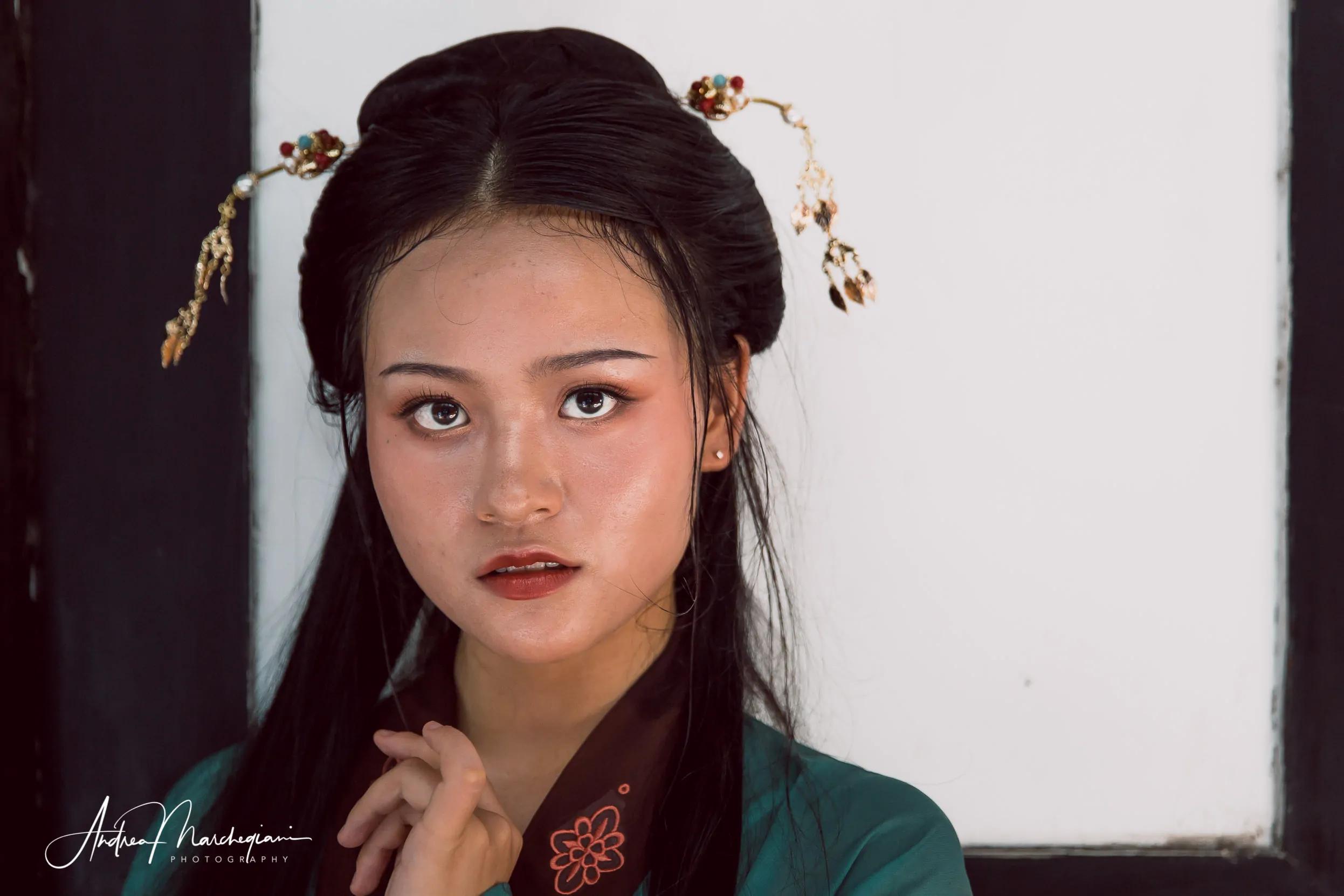
Girl in cheongsam, Chengdu, China.
A girl dressed in traditional attire, encountered by chance in a temple in Chengdu, gifts me with a quick shot. The frame of the gate in the background creates an elegant framing effect.
>>Shooting data: 1/320 f2.8 iso 500. Focal length 70mm on Full Frame.
What is a portrait photograph?
A portrait photograph is a genre whose artistic intent is to showcase the physical characteristics and psychological traits of a person. Often, the subject is isolated from the surroundings, and their facial features become the sole focus of our attention.
Other times, the environment they are placed in is clearly depicted. In this case, it is referred to as an environmental portrait, where the portion of the frame occupied by the surrounding space becomes relevant in providing information about the person being portrayed – their occupation, hobbies, social class, country of residence, etc.
A single person or a group can be portrayed: depending on the scenario, we can have family portraits, mother-child portraits, sibling portraits, or work group portraits.
If we photograph multiple individuals, it is important to understand that the viewer will question the relationship between them. Is there affinity or conflict? Are they relatives or friends? We can also leave a certain degree of ambiguity, but we should be aware that the viewer will ponder upon such a choice.
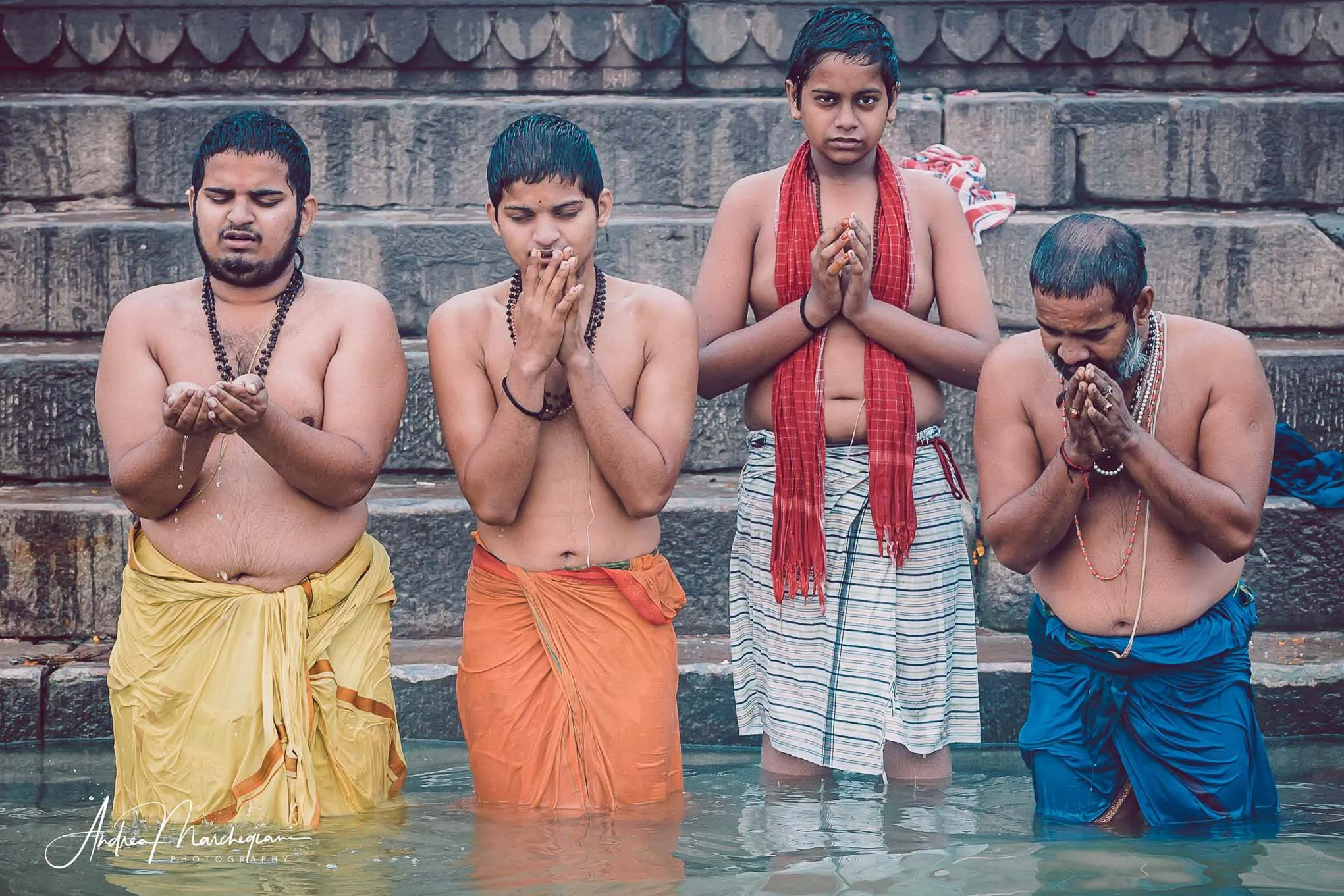
Pilgrims in Varanasi, India.
Four Hindus bathing in the Ganges River and praying. I captured the photo from a boat using a telephoto lens. The boy looking up was a lucky shot, placing the photo halfway between an environmental portrait and street photography.
>>Shooting data: 1/400 f6.3 ISO 1600. Focal length 115mm on Full Frame.
What is the most suitable format for portraits? And the best composition?
Historically, the assigned format for portraits is the vertical format, commonly known as “portrait format.” A face has a longitudinal development, so it is preferable to fill the frame with the subject’s face vertically, eliminating empty space on the sides. In practice, however, many photographers opt for the horizontal format, also known as “landscape format,” based on personal taste. I am among those who prefer this choice!
Similar freedom is found in the choice of composition: it is common to fill the frame with the subject’s face, creating a close-up that highlights their features and gaze. However, it is possible to interpret the genre in many different ways, opting for a half-length or full-length composition. The medium shot is often used for environmental portraits, where the context is as important as the subject. When framing a person, it is best to avoid cutting off the arms and legs at the joints. Cutting off elbows, wrists, knees, or ankles is considered a mistake. Lastly, if we choose to include hands and feet, it is best to include them in their entirety.
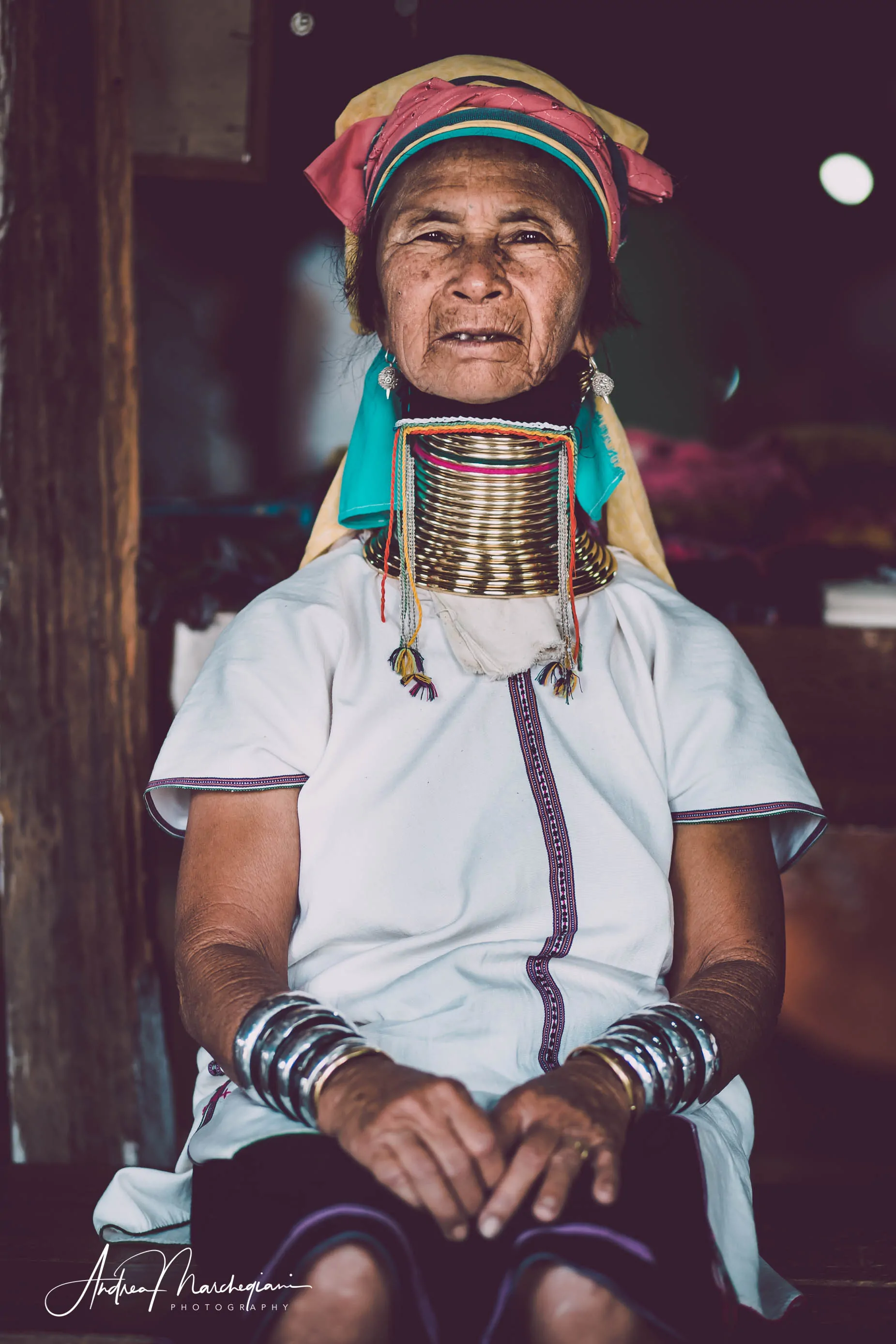
Giraffe Women, Myanmar.
Giraffe women wear metal rings from the age of 10 to achieve the effect of an elongated neck. In reality, it is the chest cavity that lowers under the constant weight of the rings. I chose to capture the image in vertical format to emphasize the elongated physique of the woman.
>>Shooting data: 1/400 f1.8 ISO 2500. 85mm focal length on Full Frame.
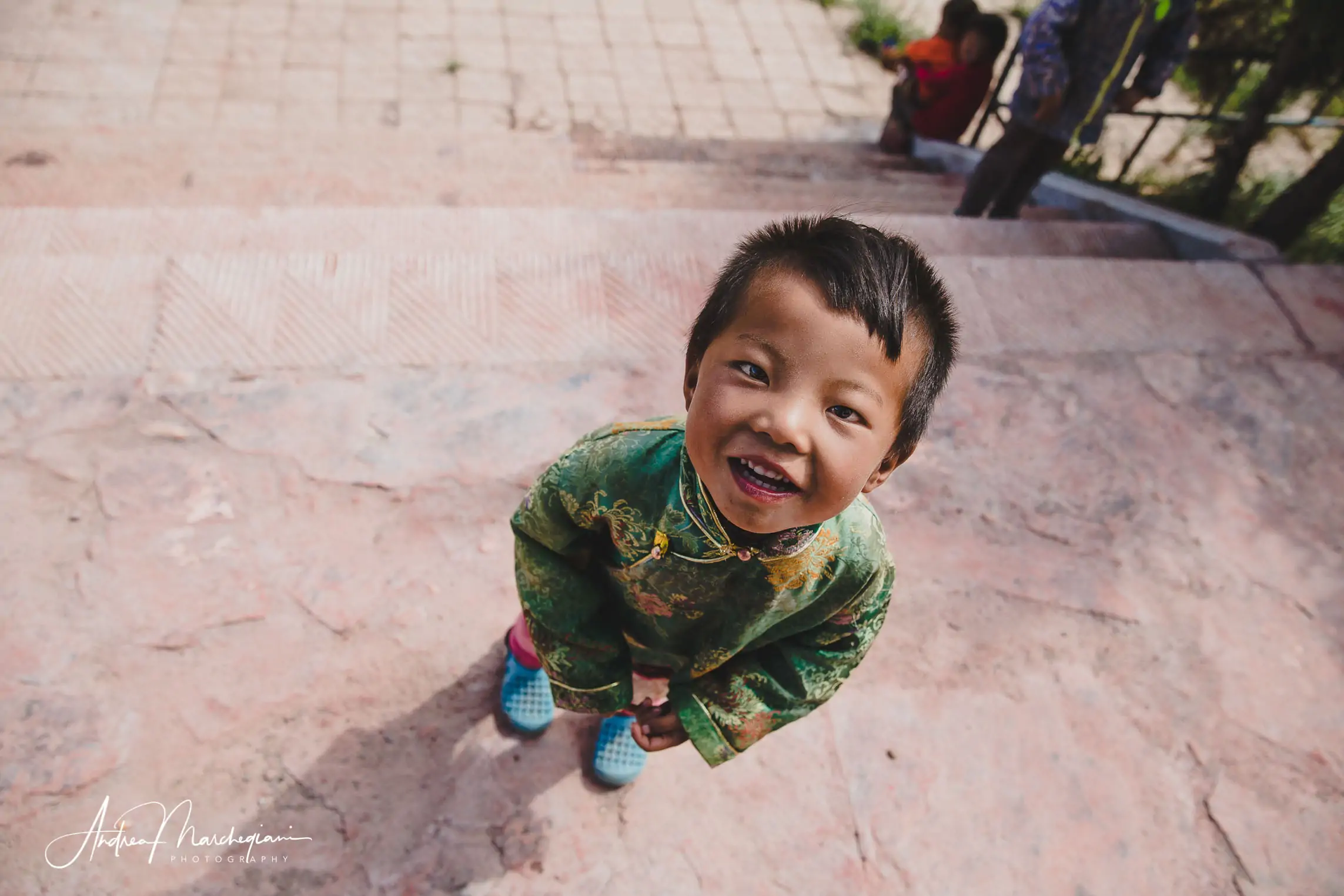
Tibetan Child, China.
I encountered this child at the Tibetan monastery of Tseway in Xiahe County. His joy and cheerfulness warmed my heart. I chose to capture him from above to emphasize the vulnerability of childhood. The confident smile he directed towards the camera and the pink flooring in the background enhance the delicacy of the subject. It evokes a desire to protect him!
>>Shooting data: 1/500 f4 ISO 100. 24mm focal length on Full Frame.
What is the best lens for portrait photography?
Usually, it is not recommended to use short focal lengths for portraits because we would have to get very close to the subject to fill the frame. This can result in facial distortion and a caricature-like effect. However, there are photographers who have skillfully used this characteristic of wide-angle lenses to their advantage, turning it into a distinctive stylistic element. The important thing is to be aware that using a wide-angle lens at close proximity to the subject can produce elongated faces and disproportionate noses.
When photographing portraits while traveling, using a wide-angle lens for portraits has an additional disadvantage. The people we choose to photograph are usually passersby, not professional models, and getting too close may make them uncomfortable or invade their personal space. I have often seen novice photographers annoy their subjects to the point of causing strong discomfort or even prompting them to flee. Therefore, I advise limiting the use of wide-angle lenses for environmental portraits where we can maintain an appropriate distance from the subject.
The preferred lenses for portraits are medium focal lengths, such as 50mm, which roughly corresponds to the human field of view, and 80mm. These lenses are almost free from perspective distortion, allow us to maintain the right distance from the subject, and produce results that we perceive as natural. When I am traveling, I go even further and use longer focal lengths. I often use a 70-200mm lens, allowing me to shoot with more discretion. In this case, we should remember that as the focal length increases, we will feel the vibrations of the camera-lens system more, and we will need to decrease the exposure time to avoid motion blur.
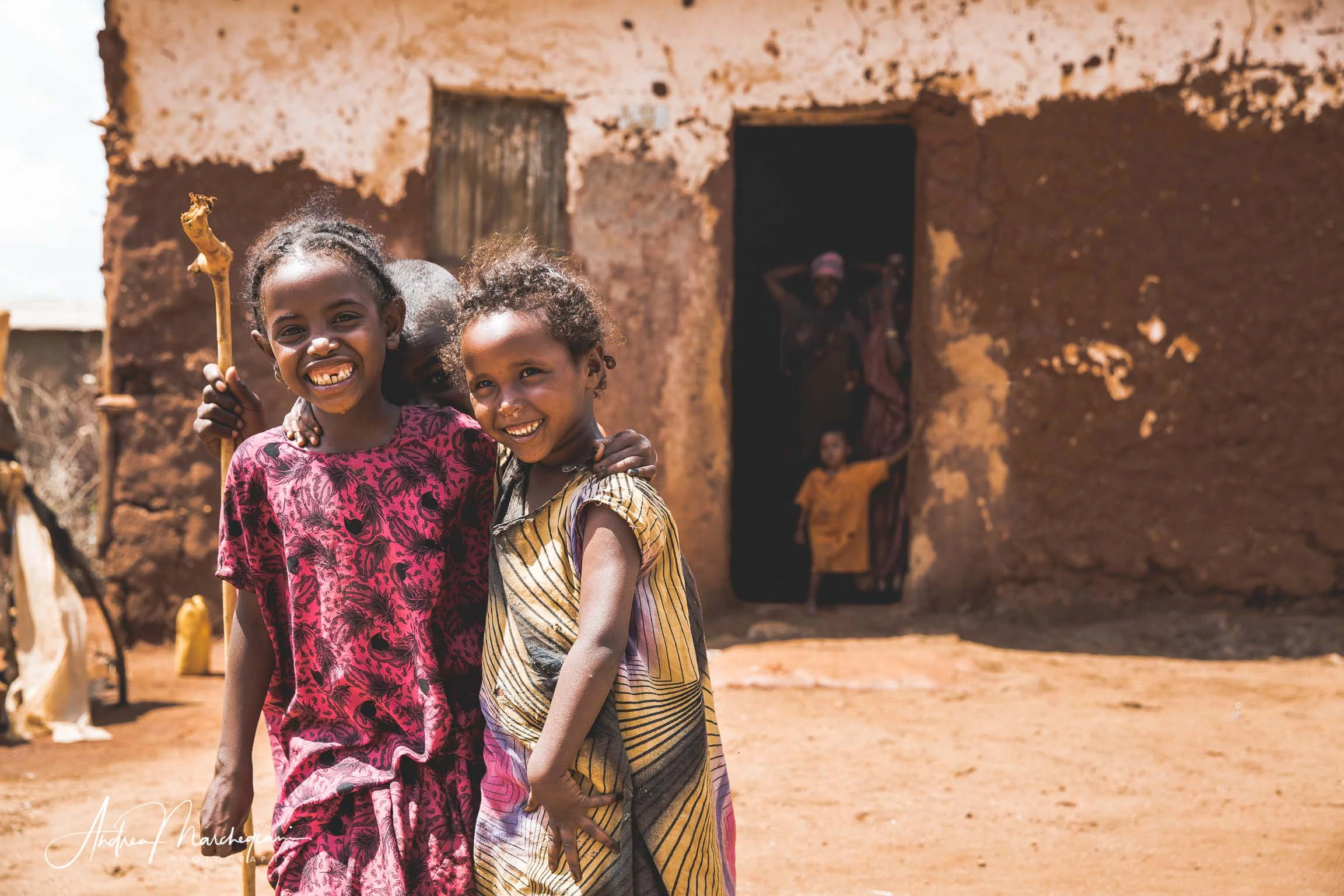
Children in Babile, Ethiopia.
An impromptu shot provided the perfect setting for an environmental portrait. Two joyful girls smile against the backdrop of their mud-brick home. At the doorway, their family watches the scene with amusement. As the African proverb goes, “It takes a whole village to raise a child.”
>>Shot details: 1/1250 f5 ISO 100. 50mm focal length on a Full Frame camera.
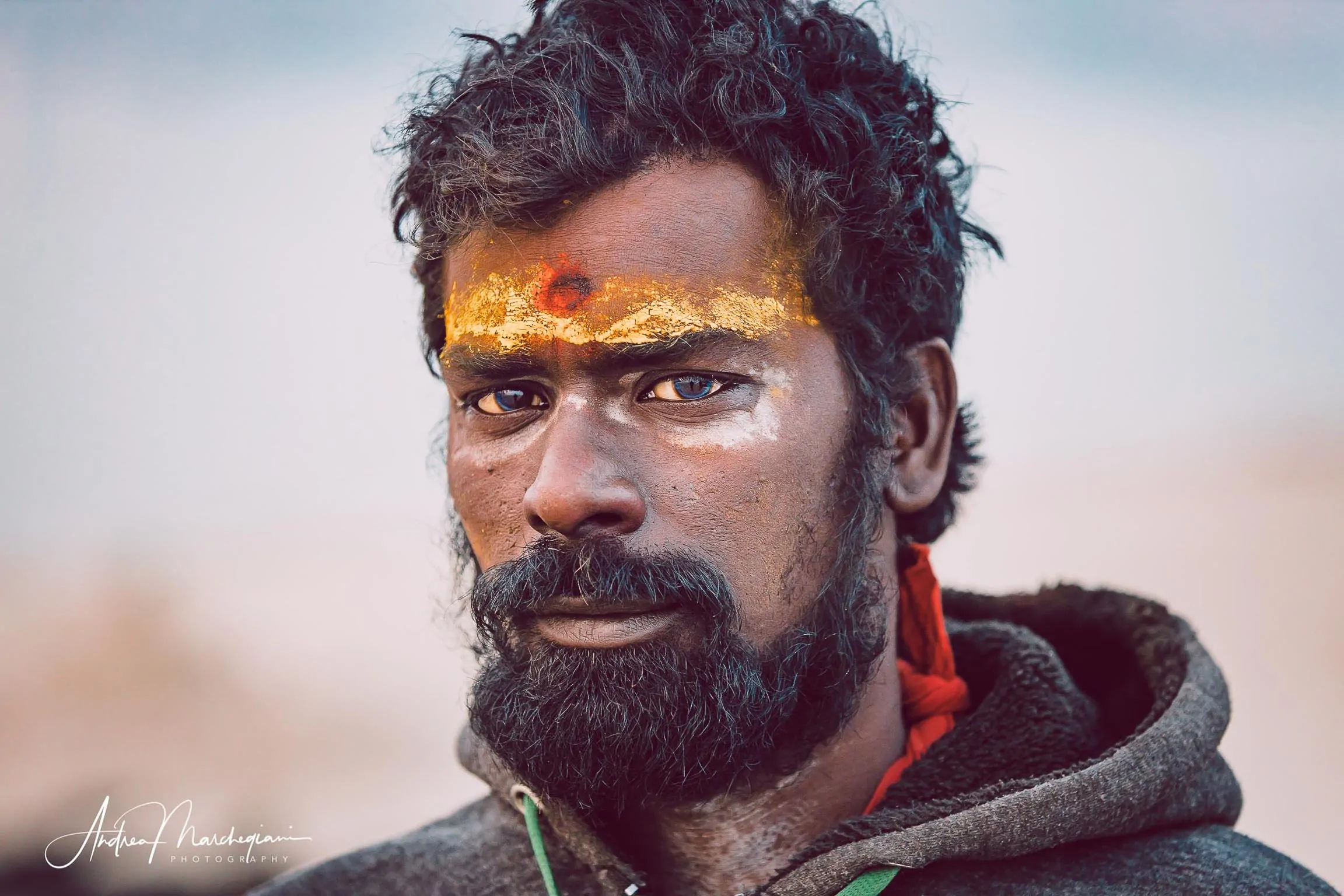
Portrait of a Sadhu, Varanasi, India.
The striking blue eyes of the young holy man take center stage thanks to the pronounced bokeh effect achieved by using a 200mm lens at f2.8.
>>Shot details: 1/320 f3.5 ISO 1250. 115mm focal length on a Full Frame camera.
How is a portrait executed?
Let’s start with the basics: in a portrait, the focus should be on the eyes. If the face is at a ¾ angle and the eyes are on different planes, it’s best to focus on the closest eye. In a close-up portrait, we want the subject to stand out from the background, so we use wide apertures that result in a shallow depth of field. If we can’t shoot at f/2.8 because we don’t have a fast lens, we still open the aperture as wide as possible. A good bokeh effect can also be achieved at f/4, as long as we use a medium to long focal length. Depth of field is inversely proportional to focal length.
We should try to keep the ISO as low as possible because the noise that is generated on the sensor as ISO is increased is particularly noticeable on skin tones, degrades overall sharpness, and smudges details. To overcome this issue, assuming we have sufficient light, we can use slower shutter speeds. If you have a steady hand and the subject is not moving, you can avoid motion blur by using a shutter speed of 1/60 or faster.
Regarding exposure, consider the skin of the face as your reference point. If the background of the subject is dark, the camera will tend to overexpose it, while if it’s lighter, it will tend to underexpose it. If you have set the center-weighted average metering mode, the amount of over/underexposure will be greater depending on how much of the frame is occupied by the background. To overcome this issue, you can use spot metering, as long as you focus on a portion of the face, or use exposure lock or exposure compensation. Consult your camera’s manual to understand where these buttons or settings are located.
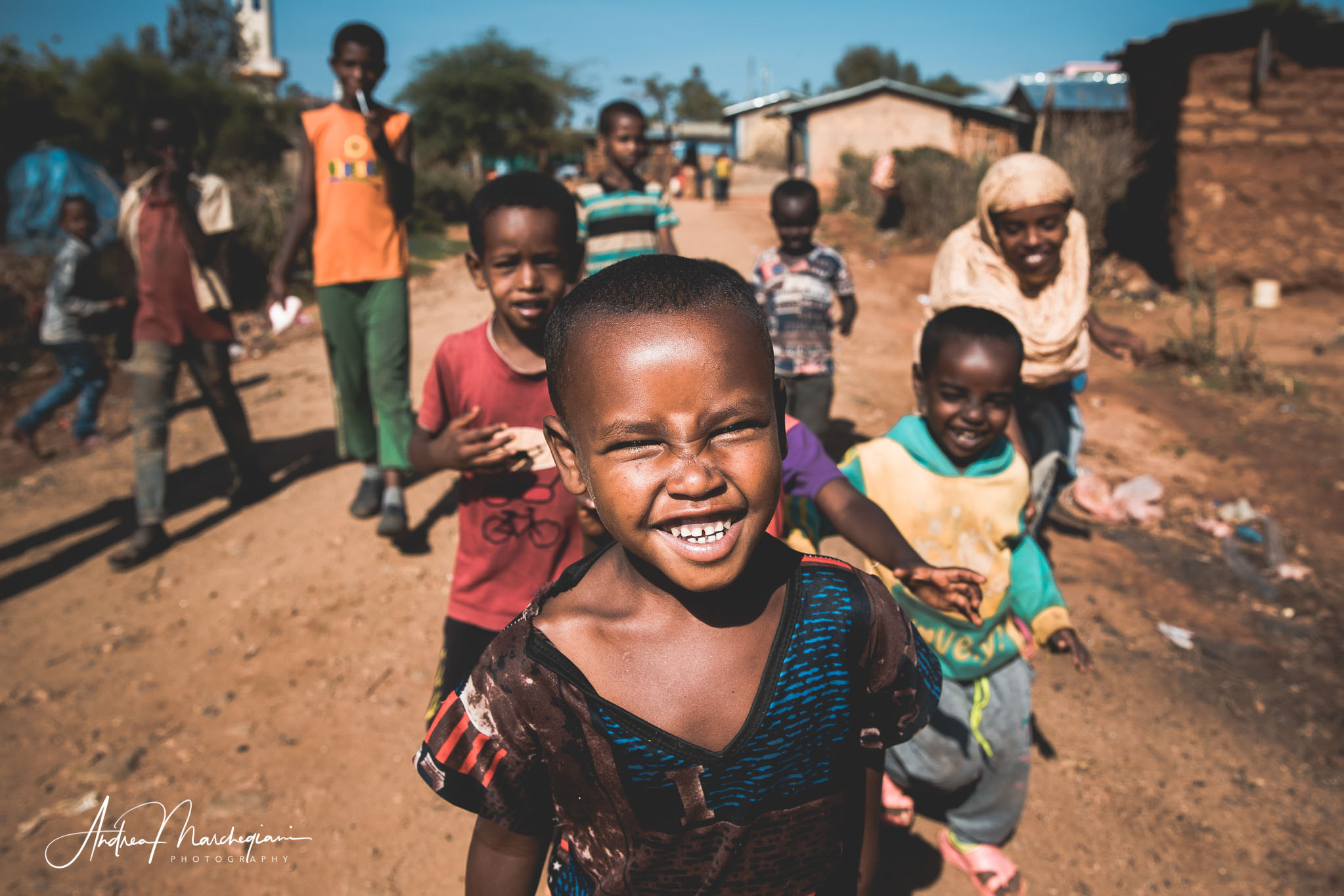
Group photo in Babile, Ethiopia.
A dynamic and chaotic shot that captures the joy of living in an African child and the vibrant everyday life of his village.
>>Shooting data: 1/1000 sec, f/4.5, ISO 100. 24mm focal length on a Full Frame camera.
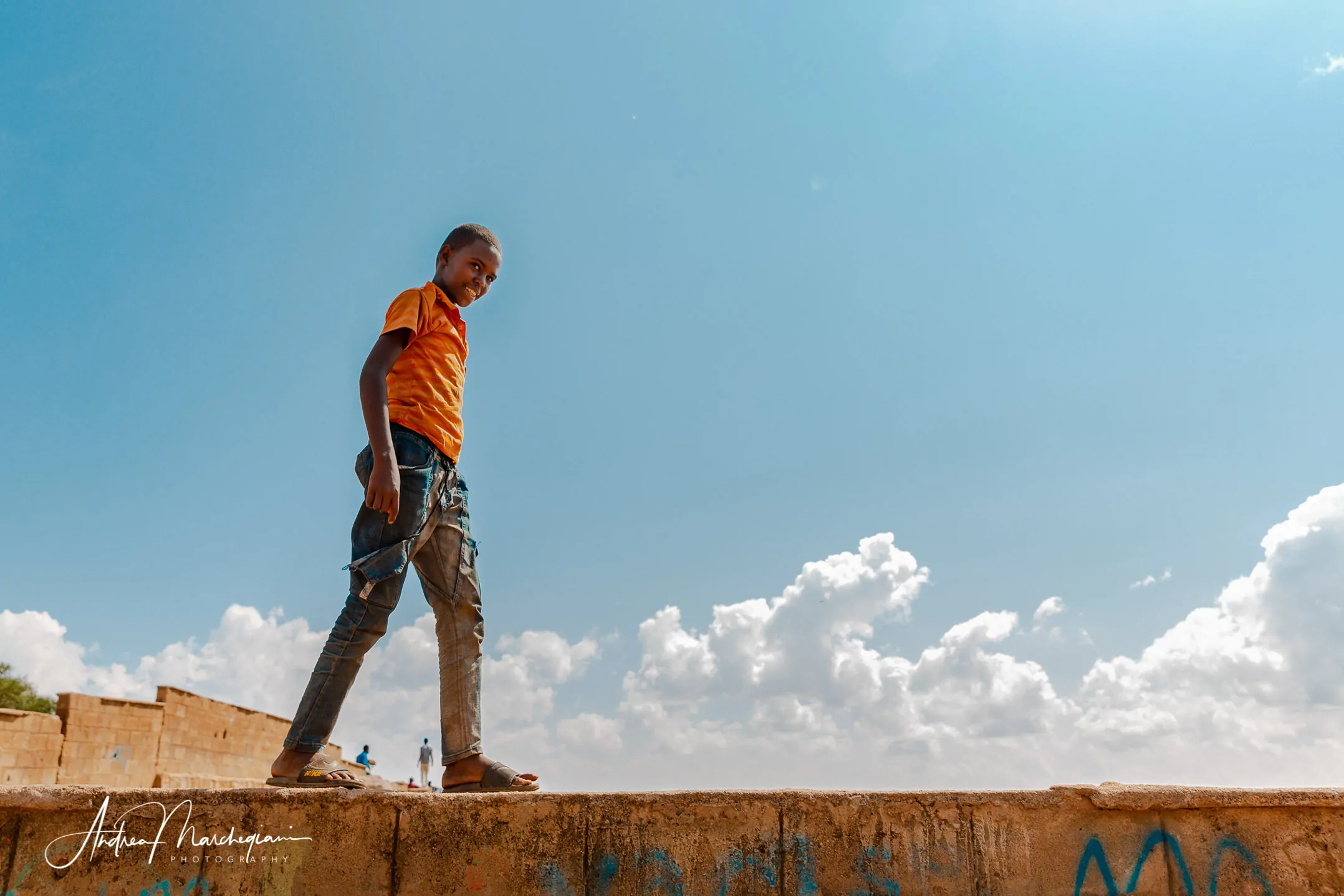
Above the clouds, Babile, Ethiopia.
A full-body portrait against the backdrop of the afternoon sky. The boy, dressed in wrinkled and tattered clothes, wears a hopeful smile, and the clouds towards which he seems to be moving promise a better future.
>>Shooting data: 1/400 sec, f/5, ISO 100. 24mm focal length on a Full Frame camera.
Rules for composition
Translation: We can compose the photo as we see fit. There are guidelines, of course, and it’s good to know them, but we can also disregard them and have fun experimenting.
Composition cuts
I’ve already suggested never to cut off limbs at the joints and to include the full extremities of hands and feet. I’ll add that it’s best never to cut off the chin and ears, even when taking a close-up. If we want to emphasize the gaze, we can cut off the upper part of the forehead, but we never interrupt the chin line.
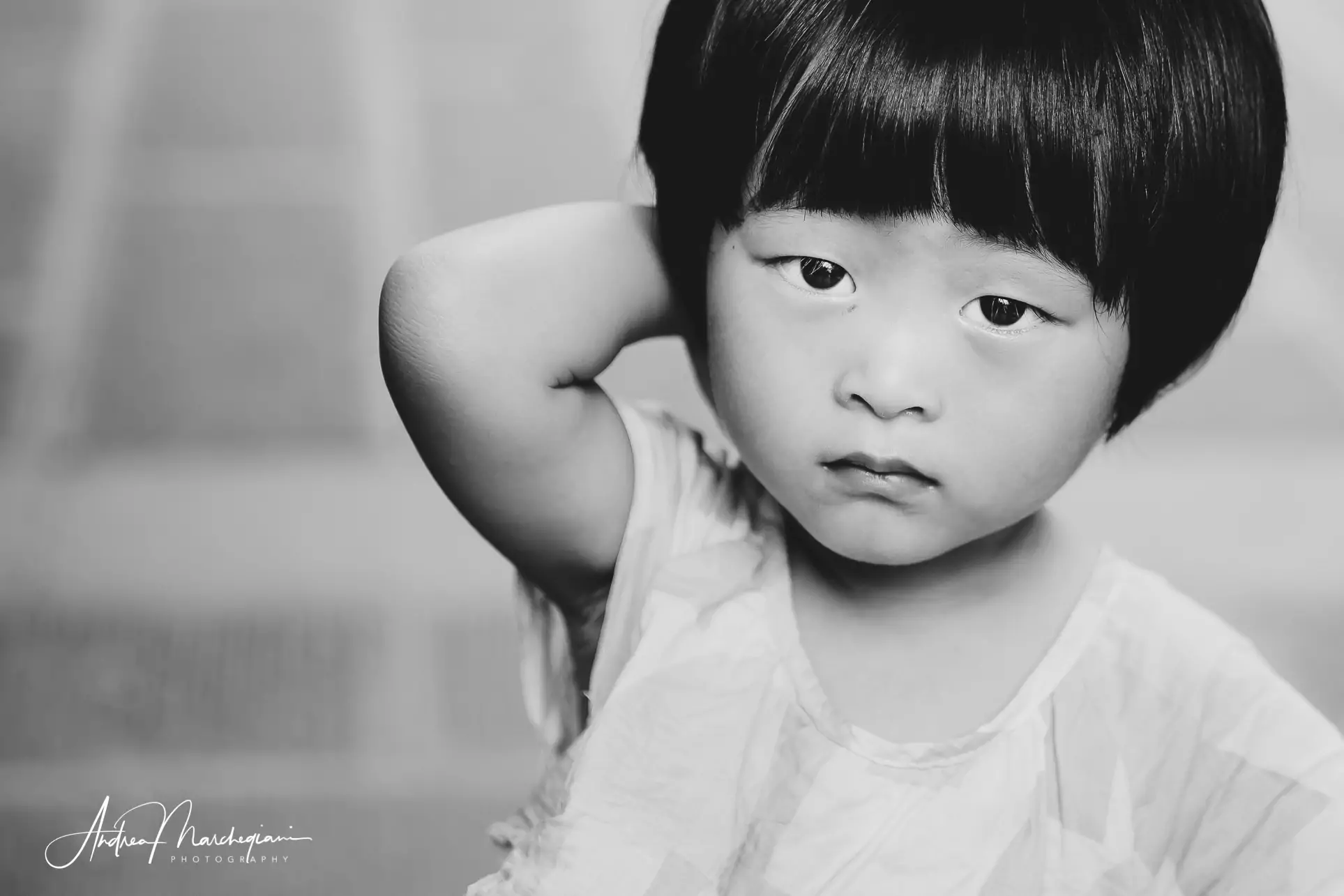
Thoughtful Girl, Chongqing.
For extreme close-ups, it is possible to crop part of the head. This allows us to follow the rule of thirds and position the eye line on the intersections of the upper line.
>> Shooting data: 1/400 f2.8 ISO 160. Focal length 70mm on Full Frame.
Angle
Another important element to consider is the angle at which we choose to frame a face. We should try to maintain eye-level with the subject, in an equal position, which is best for sharing the experiences and thoughts of the person we are photographing. If we position ourselves above the subject, we will push them down, forcing them to look up at us. The result will be a sense of oppression, inferiority, and a lack of power compared to the viewer. Conversely, if we shoot someone from a lower angle, we will accentuate a sense of dominance, power, and even arrogance towards us.
The choice of perspective also has a significant effect on the facial features: in China, at the Labrang Monastery, I took two portraits of a young monk, around 3 years old. I first photographed him from top to bottom, then I positioned myself at his eye level and took another shot. The difference between the two images is striking: they look like the faces of two different people. When I got down to the little monk’s eye level, his face took on an unprecedented maturity, revealing much more than his age.
Child Monk, Labrang, China.
Two shots of the same young monk show how the facial features change based on the shooting angle. In the top-down oriented photo (1), the child appears small and vulnerable. In the second portrait (2), I positioned myself at the child’s eye level. The conscious gaze is surprising, making him appear older than his 3-4 years. Between the two shots, I also changed the lens, switching from a wide-angle to a telephoto lens. It is interesting to note how different the proportions of the nose and eyes and the shape of the face appear.
(1) >> Shooting data: 1/800 f3.2 ISO 640. 24mm focal length on a Full Frame camera.
(2) >> Shooting data: 1/3200 f3.2 ISO 640. 120mm focal length on a Full Frame camera.
Subject on the Side
The rule of thirds and the golden ratio, which are fundamental to all compositional guidelines in visual arts, also play an important role in portrait photography. Divide the frame into 3 vertical and 3 horizontal sections, resulting in 4 points of intersection. We can use these points to position the most emphasized part of the face: the eyes. If using a vertical composition, place the eyes at the upper intersection points. If opting for a landscape format, leave the subject on the right portion of the frame, with some empty space on the left. This adds dynamic tension to the photo, as in cultures where reading is from left to right, the eye will follow the same direction when viewing images. By positioning the subject on the right, viewers are allowed to “navigate” through the space on the left, then analyze the center of the image, and finally reach the subject on the right.
Conversely, placing the subject on the left acts as a visual block, making the right half of the image less explored. This creates a sense of breathlessness and almost oppression. If photographing a person living in dramatic conditions, this type of composition can be used to intensify the feeling of discomfort. An exception is when the subject is looking from left to right: in this case, it is advisable to leave space on the right, in the direction of their gaze.
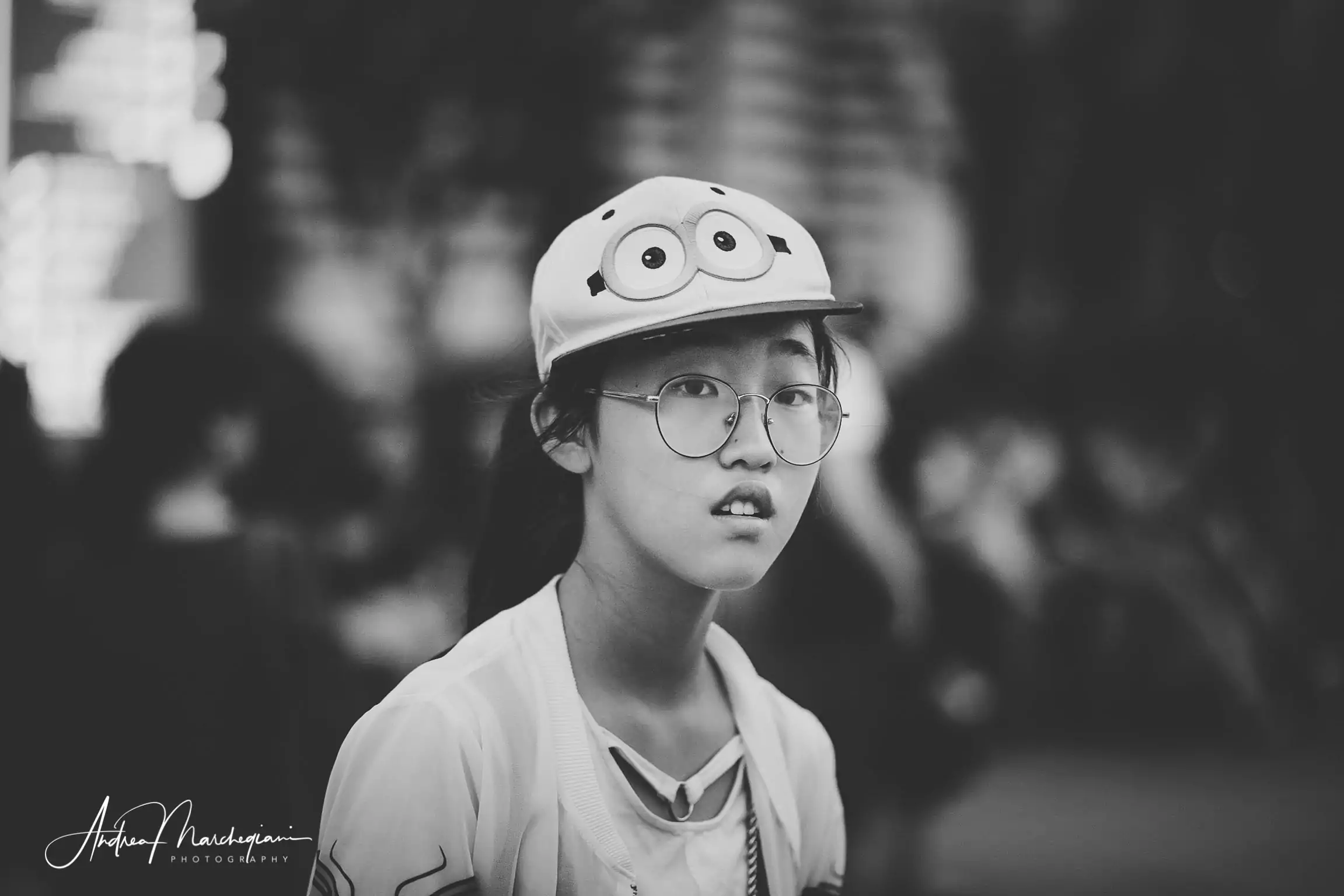
Girl with Hat, Shanghai.
The melancholic gaze of this young girl contrasts with the playful tone of the hat; the glasses she wears resemble drawn ones, adding a melodramatic touch to the scene. The choice of black and white emphasizes this atmosphere, while the empty space above and on the sides of the subject spatially expresses the sense of disorientation in her gaze.
>>Shot data: 1/250 f1.8 ISO 2000. 85mm focal length on Full Frame.
Subject at the centre
Placing the subject in the center of the composition is often considered an unoriginal solution. However, considering that the human face has two eyes, two nostrils, two cheekbones, and two ears, it lends itself well to symmetries. If we are aiming for a static, formal, and balanced result, we can position the subject right in the center of the frame. Nothing will distract us from their gaze and their state of mind. Public figures holding institutional positions are often portrayed frontally and in the center of the space precisely to highlight their character traits and moral qualities.
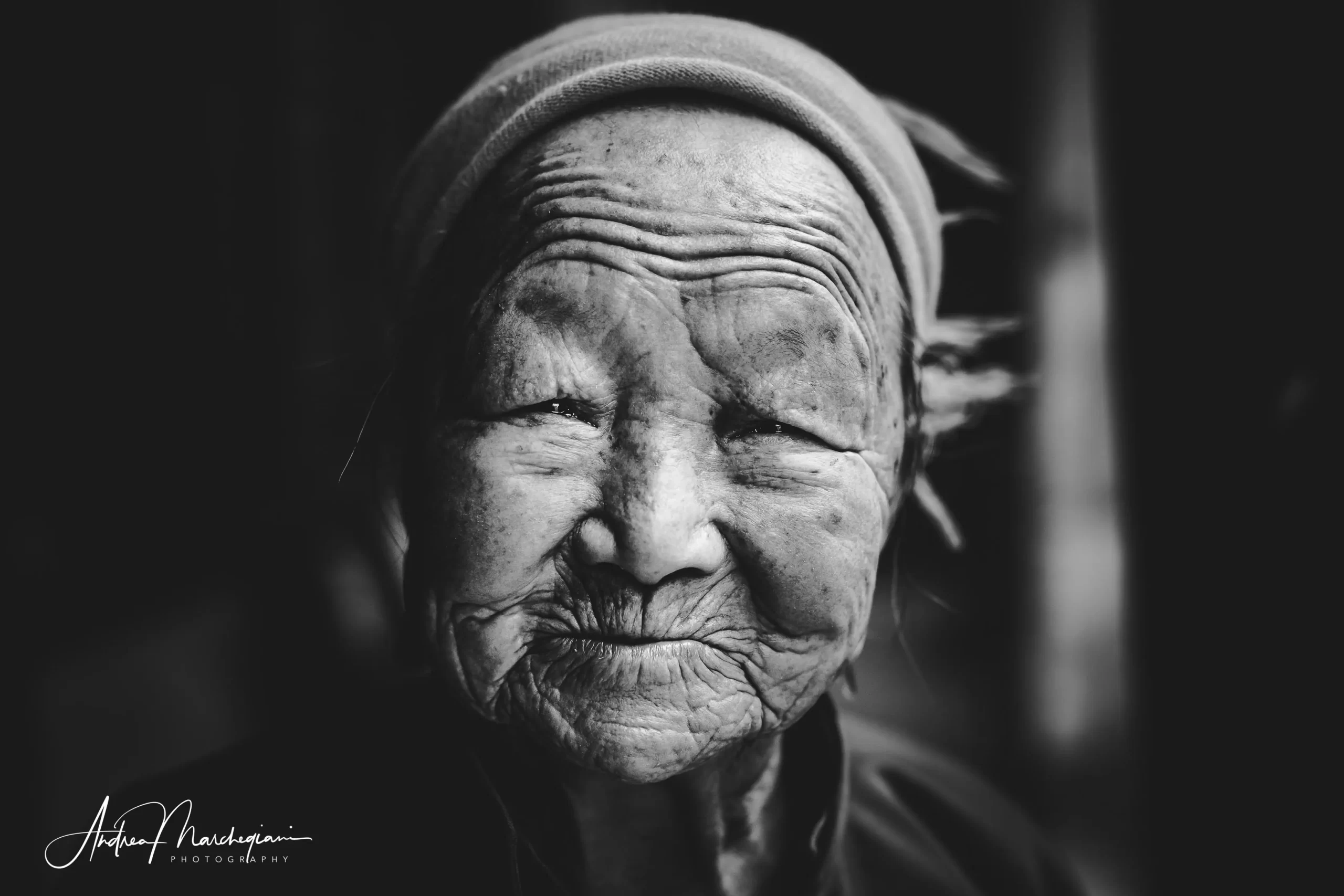
Elderly Woman in Dali, China.
The subject in a close-up shot, positioned at the center of the frame, highlights the wrinkles on her face and her expression of joyful serenity.
>>Shooting data: 1/400 f2.8 ISO 640. Focal length 70mm on Full Frame.

Peul Girl, Senegal.
A close-up shot of a girl from the Peul tribe in Sagatta, Senegal. This ethnic group, considered the most beautiful in the world, lives a pastoral lifestyle. The framing with the forehead cut off emphasizes the intense gaze of the subject, proudly challenging the camera. The texture on her cracked skin tells the story of a difficult life in close contact with the earth. Resilience and hardship, the essence of Africa.
>>Shooting data: 1/320 f4.5 ISO 100. Focal length 50mm on Full Frame.
Light
Light is one of the most important elements in a good photograph. Often, it is the light that evokes emotions in an image. Understanding the role of light requires years of study: the quality, direction, color, and intensity of light are decisive factors in the success of a shot. Therefore, it is crucial to pay special attention to it. In a studio setting, precise adjustments can be made to each of these aspects.
On the other hand, when traveling, you have to make the most of what you have. Most of the time, you will be shooting outdoors, relying on natural light. Depending on the weather conditions, your subjects may be illuminated by direct sunlight, which can create harsh lighting and strong contrasts on the face. On cloudy days, the light will be diffused, softer, but also flatter.
You won’t have the ability to position your subjects in favor of the light source, so you’ll need to be skillful in making the most of the given conditions. If your subject is backlit, you could choose to create a silhouette of their profile, or you might prefer to overexpose and “burn” the background, turning it into a flat, bright, and indistinct surface. The only truly favorable moments will be just before sunrise and just before sunset: the so-called “golden hour.” The sunlight is still soft enough not to make people squint, warm enough to create a suggestive and romantic atmosphere, and the low position of the sun on the horizon casts long shadows that add volume and drama. The golden hour will give you great satisfaction and help you capture excellent portraits.
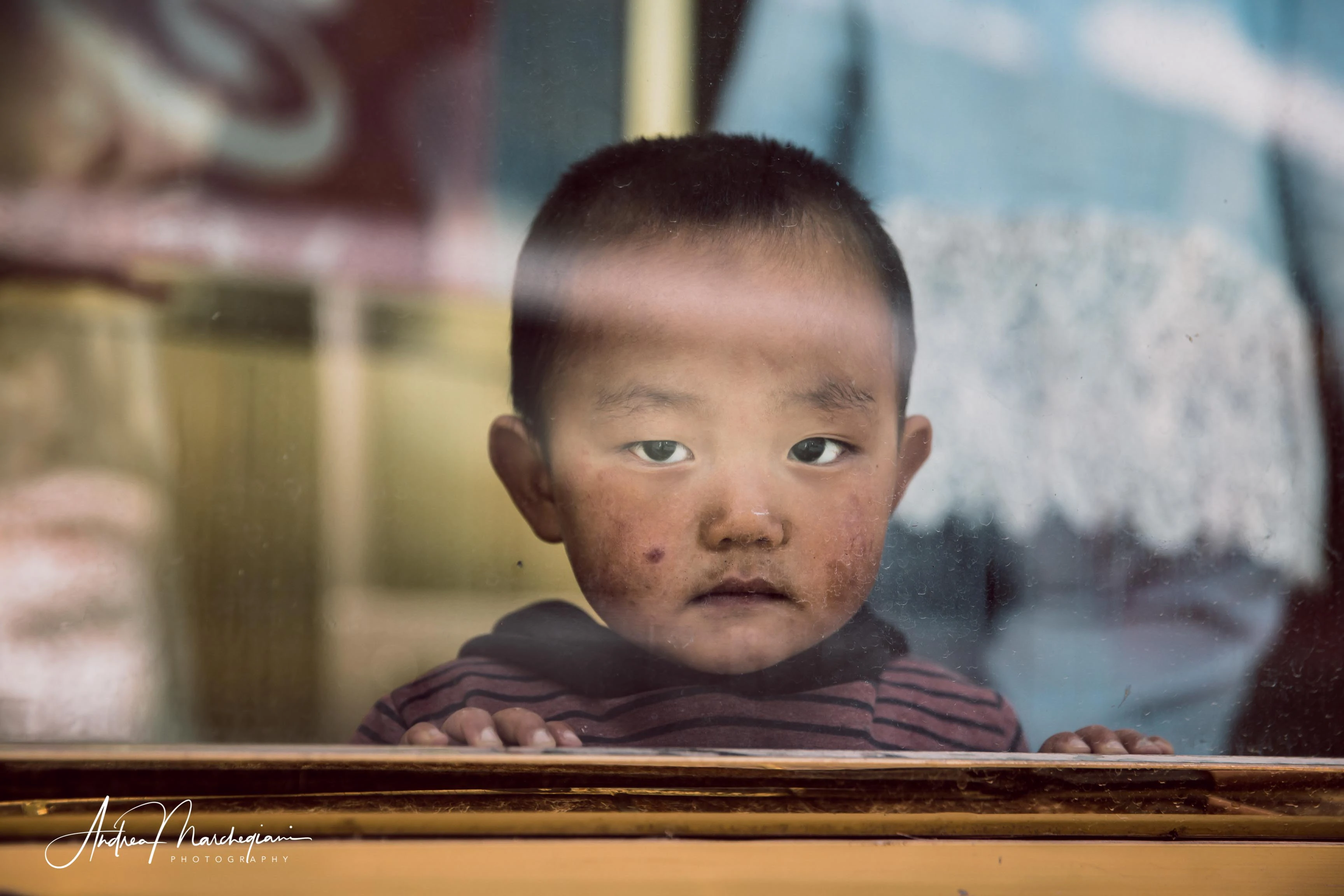
Langmusi, China.
A child looks at me through the dirty window of a shop. Amidst the reflections, a portion of the Coca-Cola logo can be seen, contrasting with the serious and melancholic expression of the subject.
>>Shot data: 1/320 f2.8 ISO 100. 70mm focal length on a Full Frame camera.
Approaching the subject
What truly makes a portrait interesting is the glimpse into the inner world that we manage to bring out. We cannot force anyone to fake an emotion, and for it to shine through, the subject of the photo must be willing to share it with us.
If we don’t know how to relate to others, it will be difficult for us to be skilled portrait photographers. Empathy should be taught in photography courses because if we don’t feel what others feel, we will hardly know when the right moment to capture is. An emotion has a temporal development and a specific outward manifestation: a photographer can trigger it in the subjects they interact with and imprint it on the sensor at the moment it reaches its peak. If we don’t get moved by other people’s emotions, we will never know when exactly to press the shutter button.
While traveling, we encounter many people. Often, they are different from us in personal history and culture, they speak another language, and practice a different religion. It may seem difficult to find common ground, but let’s not be discouraged. Experience has taught me that there is a universal language that unites us all: kindness. Let’s start by making eye contact, smiling, and showing interest. Let’s allow ourselves to be observed for a moment and ask if we can approach. Let’s exchange a few words, introduce ourselves, find commonalities, and joke about differences. In Senegal, children were amazed that my skin turned red if I pinched myself. Of course, I did nothing but let them pinch me! It’s equally important to learn a few phrases in the local language or have them taught to us. In China, where people are very reserved, I found great willingness when I asked to be taught the basics of the Chinese language.
Once we have established a connection, let’s play with the camera. Take a photo and show it to them. Ask if we can take another one. Often, I have been asked if they could have a copy: if we exchange contact information, it is important to honor that promise. After returning from a trip to India, I spent an entire day sending photos via email or Instagram.
Often, we will take photos of people who are unaware of being photographed. Struck by the beauty of a situation or a person, we can capture a stolen portrait with a telephoto lens. We are treading a fine line here because we are invading people’s privacy. Most of the time, people will realize they have been photographed after a few moments. In that case, let’s not run away! Greet them, declare that we took the shot, and show it to them. Often, they will smile and pose for us for a few minutes. If, however, the person appears bothered, apologize. Show them the photo and delete it from our memory card. Assure them that there are no more images of them and apologize again. Under no circumstances should we force the situation. There is no greater shame for a photographer than to take a photo by force or deception.
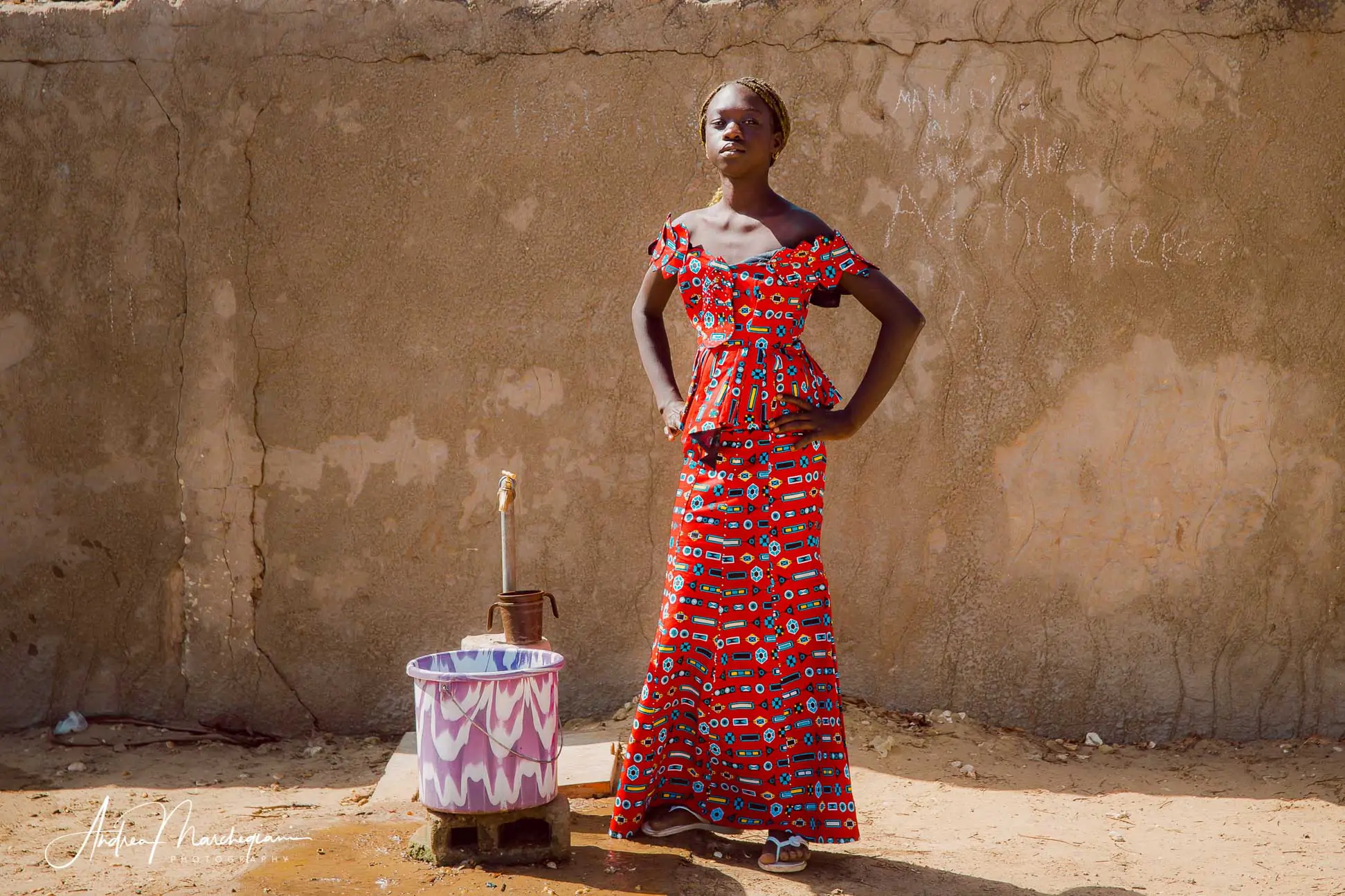
Student at the Well, Senegal.
I visited the Senegalese school in Diogane, in the Saloum Delta. A girl went to fetch water from the well. When she saw me with the camera around my neck, she struck a pose like a diva amidst the general amusement. The framing is full-body, highlighting the vibrant-colored dress.
>>Shooting data: 1/400 f5.6 ISO 200. 60mm focal length on Full Frame.
Studying the local culture
Not all countries have the same relationship with the camera, so it’s important to do some research before traveling. None of us would enjoy being photographed while walking down the street by a foreign tourist, nor would it ever occur to us to photograph a European child without first asking permission from their parents. The only reason a travel photographer can take portraits is due to the extreme willingness of the countries they visit. However, every country has its own rules. In India, you can photograph practically anyone, as long as you allow yourself to be photographed in return, while in some African tribes, taking a photo is forbidden as it is considered equivalent to stealing one’s soul.
Usually, men are more willing to be photographed than women, but it’s also true that women feel more comfortable being photographed by another woman.
When we travel, we never have certainty about what we will encounter, so it’s best to enter the countries we visit with a respectful and gentle approach. Being respectful and kind is by far the best advice to follow.



